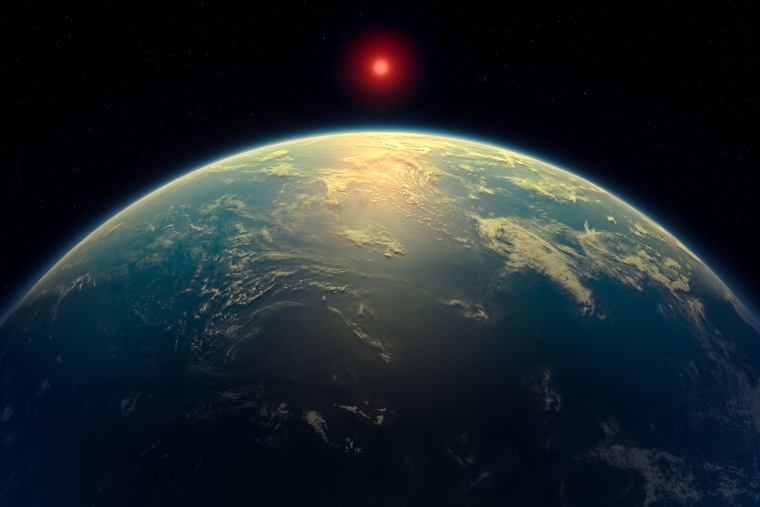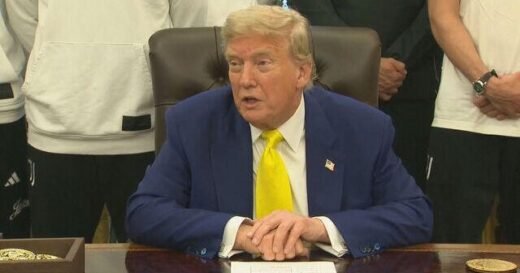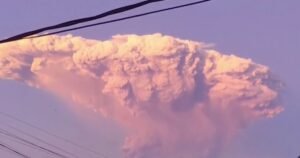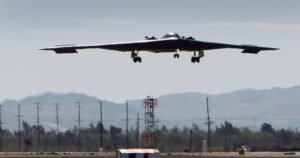Scientists detect strongest hints yet of life on a distant planet
Scientists have detected unique chemical patterns similar to those produced by the Earth’s algae and seaweed — raising the possibility of the presence of a warm ocean, perhaps teeming with life, on a planet 7 trillion miles away.
The signs were found on K2-18b, an exoplanet planet orbiting a red dwarf star twice the size of Earth and 124 light-years away, according to a team of researchers led by Cambridge University. In the scale of the universe, the planet is a neighbor, sharing the Milky Way galaxy with Earth.
They made their groundbreaking discovery after conducting a repeated analysis of observations made on K2-18b using NASA’s James Webb Space Telescope, detecting the chemical fingerprints that on Earth are primarily produced by microbial life, like algae, seaweed or marine phytoplankton.
The findings are “the strongest evidence yet that life may exist on a planet outside our solar system,” Cambridge University said in a press statement Thursday.

But the team — which published its study in the Astrophysical Journal Letters on the same day — remains cautious about what exactly the new findings can tell us about life beyond our solar system.
“It is in no one’s interest to claim prematurely that we have detected life,” Cambridge astrophysicist Nikku Madhusudhan, who led the study, said during a news conference on Tuesday.
But, he added, “We want to remain open and do more experiments and theoretical calculations” that can strengthen evidence that the molecule they detected, known as dimethyl sulfide (DMS), is present on the exoplanet that was discovered in 2015 by NASA’s Kepler mission.
Madhusudhan and his colleagues are building on their research from 2023, in which they detected carbon-based molecules in the atmosphere of K2-18b using the James Webb telescope’s mid-infrared instrument.
That finding suggested that an almost identical molecule to DMS, known as dimethyl disulfide (DMDS), could also be present on the exoplanet — the first hint that K2-18b may be a hycean world, meaning one with a warm ocean abundant with life under a hydrogen-rich atmosphere.
“The only scenario that currently explains all the data obtained so far from JWST, including the past and present observations, is one where K2-18 b is a hycean world teeming with life,” Madhusudhan said during the press briefing Tuesday.
At the same time, he noted that there was still a 0.3% chance that their observation was a statistical fluke. “We need to be open and continue exploring other scenarios,” he added.
K2-18b is part of the “sub-Neptune” class of nearly 6,000 exoplanets that have been discovered beyond our solar system since the 1990s.
Finding evidence of life in the cosmos was the “holy grail” of exoplanet science, Madhusudhan said.
Jake Taylor, an Astrophysics and Supernumerary Fellow at Oxford University, also expressed caution over the findings while adding that they were “a good first step” in the search for biosignature gases, which are found in a planet’s atmosphere and suggest the presence of life.
“I do not believe this is the biosignature detection that will revolutionize astronomy,” Taylor said, adding that DMS and DMDS molecules could also be produced abiotically, for example, in comets.
He added that a reanalysis of the data from the MIRI instrument, which has proven to be difficult among the exoplanet community in the past, along with an independent verification from a different team of scientists would “convince me that these signals are real.”
Despite the unknowns that can only be answered by repeated observations and more theoretical and experimental studies, Madhusudhan said in a video that finding signs of life elsewhere was “one of the most profound moments for me personally as well as an astronomer.”
He added that even suggestions of “a new chemical process that is not produced by life,” could be a monumental breakthrough, because, “however you put it, we are seeing new chemical processes on a planet that could be habitable.”
“This is, in my view, a transformational moment for finding our place in the universe as a species,” he said.
You may be interested

6/18: The Daily Report – CBS News
new admin - Jun 19, 20256/18: The Daily Report - CBS News Watch CBS News Meg Oliver reports on President Trump's latest comments on U.S.…

Trump on potential Iran strike: ‘I may do it. I may not do it.’
new admin - Jun 19, 2025President Trump said he has not made up his mind about whether to launch an airstrike on an Iranian nuclear…

Can it be made in the USA?
new admin - Jun 19, 2025[ad_1] President Donald Trump’s family business is taking preorders for a gold-colored smartphone, the T1. Trump Mobile, which launched Tuesday,…































